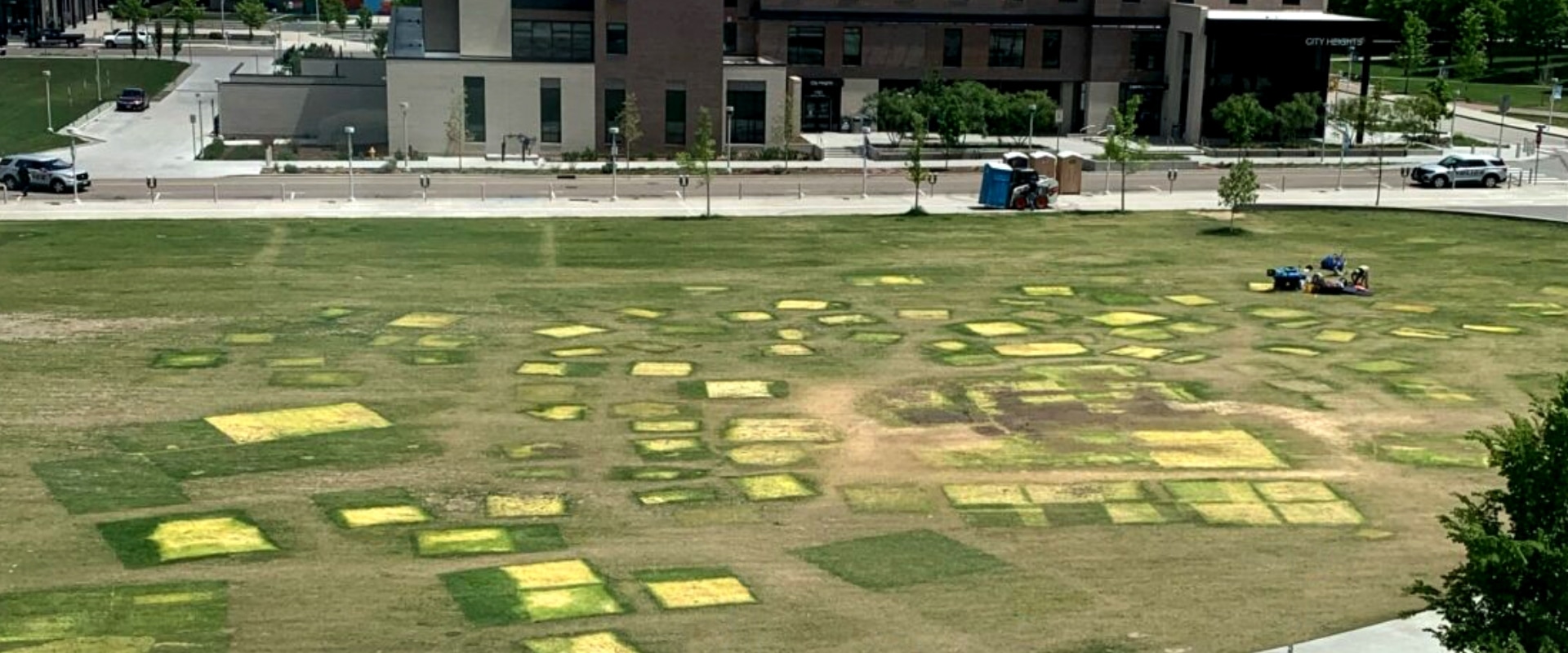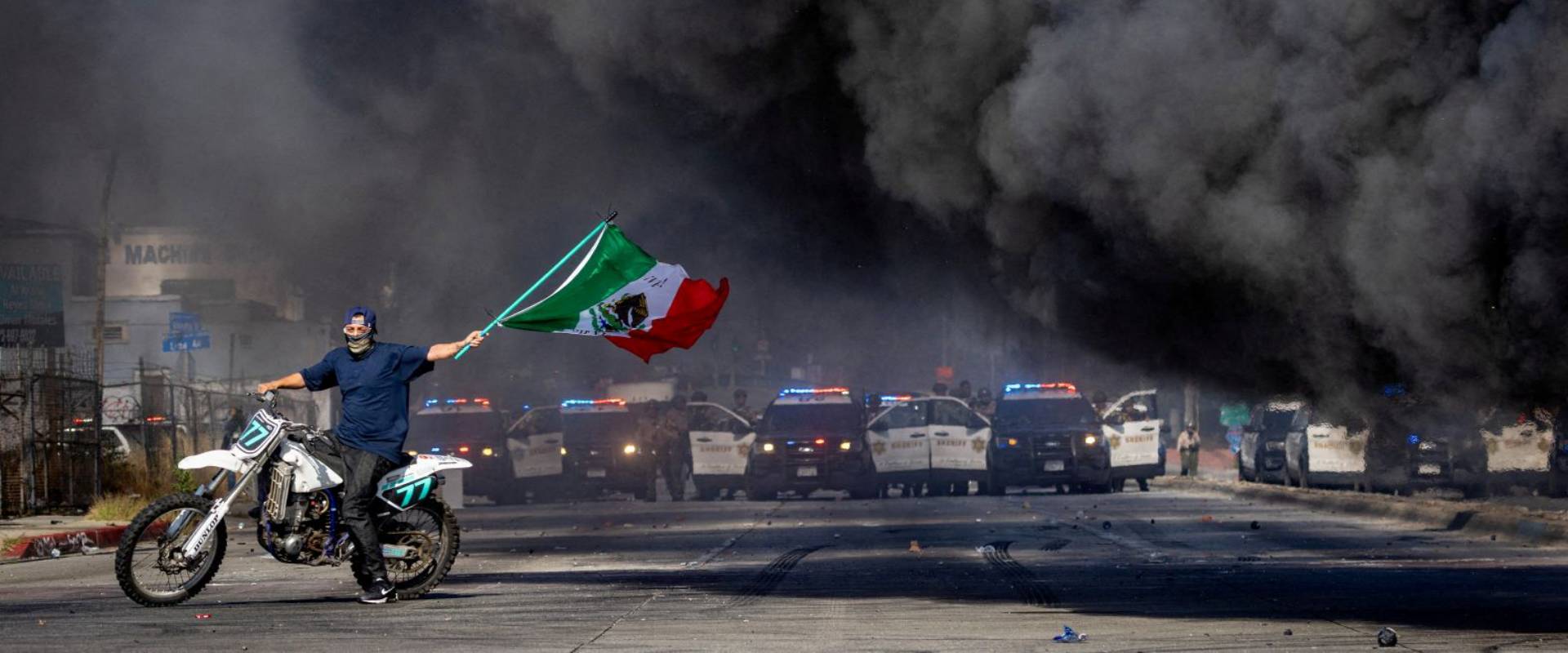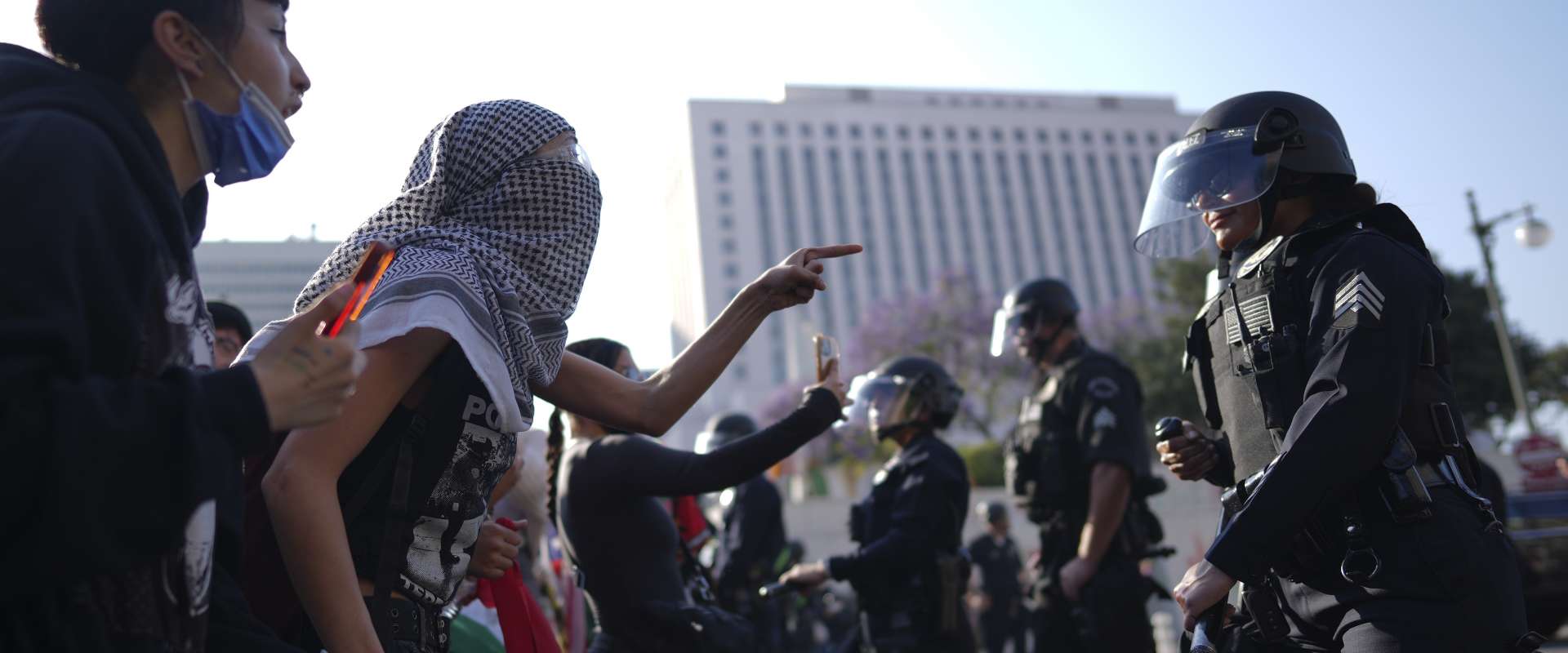The eruption of Gaza solidarity encampments on college campuses around the world has been a welcome and unexpected shot in the arm for the Palestine liberation movement. In hindsight, the pot simmered on campuses for months before boiling over. Last fall, universities around the country suspended chapters of Jewish Voice for Peace (JVP) and Students for Justice in Palestine (SJP) on specious grounds. Supporters of Palestine were attacked by doxxing trucks circling campuses and, at Columbia University, skunk spray.
Early this year, a new McCarthyist assault on academic freedom presaged a literal police assault on students and faculty daring to use that freedom. Many professors were fired or put on leave for expressing solidarity with Palestine, and Harvard’s first Black woman president resigned for being insufficiently Zionist.
On April 9, a UC Berkeley law professor attacked a student giving a pro-Palestine speech at a dinner for law school graduates. A week later, the University of Southern California canceled the commencement speech of their valedictorian, Asna Tabassum, after Zionists smeared her pro-Palestine views as antisemitic.
A new intifada is born
On April 17, Columbia students established the first Gaza solidarity encampment. They set up tents on campus and demanded divestment from companies and institutions that profit from the Zionist entity, in addition to an academic boycott of Israeli universities and an end to policing on campus. The camp was smashed by the NYPD the day after it was erected, thanks to a cartel of billionaire bosses pressuring the mayor of New York.
But instead of quelling dissent, the brutal police attack escalated it and multiplied it across 140 US campuses and 25 countries around the world (at last count). Encampments spread as if authorities had thrown water on a grease fire. The proliferation of student protests caused by a harsh crackdown follows a pattern seen in Berkeley in 1964, Paris in 1968 (and many times since), South Korea in 1980, and South Africa in 2015.
When political horizons open up and radical change begins to seem possible, those in power leap into action to renarrow those horizons and reassert the status quo. Repression alone has limits and can backfire; a carrot-and-stick strategy that combines it with minor, partial, or merely symbolic concessions works best.
Expressions of gratitude and praise for the encampments poured forth from Gaza. Palestinians and campus activists exchanged messages with spraypaint on the sides of their tents, some pitched in Rafah refugee camps, others in Ivy League quads. One of Gaza’s most cherished social-media reporters, 25-year-old “Wizard” Bisan Owda, posted, “I’ve never felt hope like now. Never.” Gazans christened the movement-within-a-movement “the student intifada.”
The student protesters have demonstrated tremendous tenacity, creativity, combativity, and dedication to Palestine. In addition to encampments, protesters have engaged in sit-ins, teach-ins, street blockades, disruptions of graduation ceremonies, demonstrations at regents’ homes, and building occupations — most famously, militantly, and lastingly at Cal Poly Humboldt. Some encampments grew to include libraries, medic and mess tents, Muslim daily prayers, Jewish Passover seder and shabbat dinners, and their own graduation ceremonies.
Academia’s role under capitalism
The function of higher education is to reproduce ruling-class ideology and prepare students to work for or manage on behalf of capital. Elite schools train those who will eventually run the state, media, and other bourgeois institutions and corporations. The Gaza solidarity encampments have exposed universities’ specific role in relation to Palestine: to ideologically justify, materially fund, and profit from Zionism and imperialism.
The fact that schools, and particularly Ivy League schools, have become breeding grounds for anti-Zionism and anti-imperialism poses a threat to the ideological and institutional reproduction of capitalism. “The refusal of appreciable numbers of students to go along to get along” is intolerable to the ruling class.
Rewarding civility and compromise while punishing disruption and defiance is a tried-and-true way to neutralize social movements. “Good protester versus bad protester” narratives aren’t only aimed at the general public, but at the movement itself — much of which may accept the logic of its enemies.
The camps have also exposed bourgeois society’s lack of respect for its own self-proclaimed values, rights, and institutions. Our rights to free speech and assembly depend on the content of that speech and the convenience of that assembly. Institutions of higher learning — supposedly dedicated to academic freedom, critical thinking, and the pursuit of truth — have brought in “outside agitators” with badges and guns to terrorize and evict students with six-figure debts that prove they belong there. USC censored their valedictorian, their best-trained student, to suppress her training — specifically her training in resistance to genocide, which was her minor.
Universities have continued to romanticize and recruit on the basis of their radical history, while trying to suffocate their radical present. The occupation for Palestine at Columbia was smashed on the 56th anniversary of the smashing of the occupations against racism and the Vietnam War at Columbia.
Obstacles and pitfalls
The first obstacle faced by the encampments has been repression by the police and school authorities. Over 3000 protesters have been arrested in the US so far. In addition to directing the police attacks, schools have censored, suspended, and expelled student protesters, and evicted them from their housing. When political horizons open up and radical change begins to seem possible, those in power leap into action to renarrow those horizons and reassert the status quo.
Repression alone has limits, and can backfire; a carrot-and-stick strategy that combines it with minor, partial, or merely symbolic concessions works best. Though touted by the left as a victory, Evergreen State College in Washington was able to placate protesters into dismantling their occupation by merely setting up a task force to assess its investments. Many others decamped after similar “wins.”
Rewarding civility and compromise while punishing disruption and defiance is a tried-and-true way to neutralize social movements. “Good protester versus bad protester” narratives aren’t only aimed at the general public, but at the movement itself — much of which may accept the logic of its enemies. The “outside agitator” narrative, which asserts that only students and faculty are legitimate protesters on campus, has been adopted by many protesters and successful at undercutting solidarity, support, and the expansion of the movement.
In addition to being attacked or co-opted by police, school administrators, vigilantes, state officials, and the media, the movement has had to grapple with internal political limitations — pacifism, reformism, electoralism, and respectability politics.
Vigilante violence has been another obstacle for the student intifada. Zionists joined forces with white nationalists and neo-Nazis to attack the UCLA camp with metal rods, planks of wood, fireworks, and bear mace, sending 25 students to the hospital. Police stood by and watched, then used the attack as a pretext to smash the severely weakened camp the next day. This “melding of state and mob violence” is a scaled-down version of the cooperative rampage that Israeli Occupation Forces and Zionist settlers have been on in the West Bank since October 7. Gaza solidarity encampments around the world have since been subjected to copycat vigilante attacks.
Meanwhile, it is the encampments that have been branded as unsafe or even violent — simply for their use of liberatory slogans. The Biden regime, bourgeois media, and the Anti-Defamation League (ADL) have slandered protesters as antisemitic, even as Jewish activists have led the protests. Robert Kraft, billionaire football-team owner and megadonor to both Donald Trump and Columbia University, bashed students with full-page ads in several newspapers.
In addition to being attacked or co-opted by police, school administrators, vigilantes, state officials, and the media, the movement has had to grapple with internal political limitations — pacifism, reformism, electoralism, and respectability politics. Liberal identity politics and “centering Palestine” has served as a rationale to make protesters obedient, well-behaved supporters lacking a political stake in the fight.
When each encampment was established, the immediate question was how to persist despite police repression. For many, the question quickly became how to persist despite a lack of police repression. For instance, after an early effort to destroy the camp on Denver’s Auraria campus, police and school officials mostly ignored it, limiting its media impact and allowing the inherent difficulties of maintaining an occupation to do the job for them.
Top-down organizing
In addition to SJP, JVP, the Palestinian Youth Movement (PYM), and various local groups and coalitions, many camps have been organized by socialist organizations with campus presences. These include Freedom Road Socialist Organization (FRSO) — mostly through their national front group, Student for a Democratic Society (SDS) — and the Young Democratic Socialists of America (YDSA). Though there have been reports of democratic discussion and decision-making bodies, the encampments have generally been run in a top-down manner by small groups of activists, as is typical of social-movement activism.
Some organizers have used exclusionary and opaque decision-making processes, fueled by security culture and sectarian desires to control and own the movement.
When Rutgers University agreed to some concessions, including to merely discuss the possibility of divestment, “The decision to accept the deal offered by the administration wasn’t put to the encampment itself, but made by the unelected leaders, with the help of a few faculty advisors, before the hundreds of people who made up the camp and the wider sectors supporting them had the opportunity to play an active role in developing strategy for the camp.”
Some organizers have used exclusionary and opaque decision-making processes, fueled by security culture and sectarian desires to control and own the movement. In these contexts, despite comprising the base of the movement, all but a select, unelected few have been excluded from helping to determine its next steps. This approach constrains protesters’ political, strategic, and tactical development, which are necessary to advance the movement and class struggle more broadly. As a veteran student organizer from UC Santa Cruz explained, “The best way to protect an illegal and risky action on campus is with hundreds or thousands of people who feel ownership of that, who feel like it’s something we’re all doing together.”
Few material gains
Few encampments have won much in the way of disclosure and divestment. Many university administrations were able to get camps to disperse by promising only to discuss the matters.
The Brown University and faculty-led New School encampments pulled up stakes when their schools agreed to vote on divestment later in the year. Harvard agreed to discuss its endowment and reinstate suspended students. The University of Washington agreed to evaluate a proposal to divest from Israel, to be “transparent” and “examine” the University’s relationship with Boeing and other weapons manufacturers, and to waive tuition for at least 20 students from Gaza. Portland State University paused receiving gifts and grants from Boeing until it holds a forum to debate their ethics.
Some encampments won promises to disclose sometime in the future. Northwestern University students ended their encampment after administrators agreed to disclose their investments and increase support for Palestinian students and faculty on campus. In Denver, Metropolitan State University agreed to disclose their investments sometime in the future, and the University of Colorado Denver didn’t move an inch. After Bard College students occupied an administrative building for a weekend, the tiny school in upstate New York agreed to disclose its investments, elect an investment-ethics committee, and to challenge the New York state executive order that bans investments in companies that boycott Israel.
The only disclosure that has been made so far was by the University of California school system, which disclosed $32 billion invested in weapons manufacturers and other companies targeted by students. The next day, they said they had no plans to divest. The student intifada’s biggest victory was won at Ireland’s oldest university, where a five-day encampment convinced Trinity College Dublin to divest — the only actual divestment so far.
Limits of student power
The unique social position held by students provides both advantages and limitations to their ability to advance social struggle. Though far from the utopian bastions of intellectual pursuit they claim to be, campuses remain one of the few sites where left-wing ideas can be openly explored. And with fewer financial responsibilities than workers, students can be more inclined to rebelliousness and risk-taking. This context gives students “significant power to ignite and expand movements,” makes them ”more volatile, and sensitive to shifts in the ideological climate,” and puts them at the forefront of emerging periods of radicalization.
But students cannot paralyze production. They lack precisely the “structural leverage” that Spectre Journal’s overly optimistic assessment ascribes to them. Though they have captured the imagination of the world and revitalized the Palestine liberation movement, even the most successful and militant encampments have barely disrupted business as usual.
Students can provide the initial electrical charge, but to shock the system, it needs to jump circuits and become a wider social crisis, ultimately at the point of production. The best example of this phenomenon was in France in 1968, when police repression of student occupations led trade-union confederations to call for sympathy strikes that quickly turned into the largest general strike in history — and a wildcat strike at that. Echoing this dynamic, academic workers at the University of California are currently on an inspiring political strike that has taken up the movement’s demands for disclosure, divestment, cutting ties with the Zionist entity, and the defense of protest.
Leaps forward in consciousness
Alongside few material gains, the student intifada has made significant ideological advances. “At the end of the day, the demands are vital,” according to a Bard College student protester, “but what is most important about what happened here was the building of community around radical political education and building solidarity across class, across all backgrounds.” While Marxists seek to sharpen class lines, rather than paper over them, the overall point is a good one.
Arab and Muslim youth have resurrected the spirit of student radicalism that helped end the Vietnam War and South African apartheid. A new generation of Jewish activists has decoupled Judaism from Zionism, and anti-Zionism from anti-semitism. The movement has gone beyond condemning the particular policies of the apartheid state to condemning its very existence.
This chapter of the Palestine solidarity movement has shattered previously impenetrable paradigms, seeded the ground for a new generation of activists, and proliferated anti-imperialist and socialist politics.
Thousands have been willing to engage in disruptive and illegal action for Palestine. Most have followed the model of passive civil disobedience that has been held up as the only proper approach since the civil rights movement. Cal Poly Humboldt students responded to police batons by bonking the police with a water jug and chanting “We are not afraid of you!”
This chapter of the Palestine solidarity movement has shattered previously impenetrable paradigms, seeded the ground for a new generation of activists, and proliferated anti-imperialist and socialist politics. But durable organizational forms are needed to “maintain the gains in mass consciousness.”
How will the status quo reassert itself?
The whole ruling class and both of its parties are unswervingly dedicated to the US imperial project. The Zionist state plays a critical role in that project, as watchdog, weapons laboratory, and, in Netanyahu’s words, “mighty aircraft carrier of our common civilization.” Democrat and Republican officials, the police, media, and their own schools, have all been arrayed against the students. To support Palestine, as it turns out, one must oppose the whole system. This creates greater potential for radicalization than other issues.
With the lesser evil drenched in the blood of 37,000 and counting, lesser-evilism makes less sense than ever. A new generation has experienced the lesser evil behaving just like the greater evil due to “the increasing convergence of liberalism and conservatism.”
We must do everything we can to help popularize, democratize, proletarianize, nationalize, and internationalize the movement — as well as to sharpen its politics.
The emergence of the term “Genocide Joe” was a political step forward for the movement last fall. But it will become a setback if blame is limited to Biden, rather than his whole genocidal party and its ugly fraternal twin, the Republican Party — in addition to the class they represent and the capitalist system itself, which underpins all imperialism. Similarly, we don’t stop at blaming Netanyahu or the Likud Party — we blame Zionism.
When Denver’s Democrat mayor tried to appeal to the encampment his police had just brutalized, a member of the Denver Communists shouted him down with, “The Democrats are over!” This unleashed the fury of the crowd, which admirably wouldn’t let the mayor get another word out.
But are the Democrats over? Will the Palestine solidarity movement break from the party, or just from Biden and his regime?
It’s not looking good. The compounding errors of popular-front politics, electoral fetishism, and lesser-evilism predominate in the Palestine solidarity movement. From the beginning, most participants have considered the movement to be a pressure campaign on the Democrats, rather than an effort to develop the independent power of working-class and oppressed people and flex it in our streets, schools, and workplaces. This was perhaps most clearly evident in the campaign to vote “uncommitted” in the Democratic Party primaries, which was not a rebuke of Biden, but an effort to save his chances of reelection.
Many who honor the martyr Professor Refaat Alareer ignore his last tweet: “The Democratic Party and Biden are responsible for the Gaza genocide perpetrated by Israel.” The Squad has managed to retain their progressive bona fides despite being party to genocide and repeatedly voting to fund and support the Zionist entity. Jamaal “Iron Dome” Bowman’s campaign for reelection was just endorsed by the New York City Democratic Socialists of America (DSA) — because his opponent’s Zionism is more virulent than his own. Under the slogan “Palestine is on the ballot,” the DSA and some Palestine coalitions have prioritized campaigning for Democrats over pro-Palestine activism, and worse, combined and blurred the lines between the two. Democratic candidates have been allowed to turn Gaza solidarity encampments into campaign stops, including those who have condemned Palestinian military resistance, like Greg Casar in Austin, Tim Hernandez in Denver, and Dean Preston in San Francisco.
The two-fold task of communists
The encampment tactic has mostly exhausted itself for now, at least in the US, but the wider movement it’s a part of lives on and should learn from it. As communists, we fight for “immediate aims” as part and parcel of the wider fight against the whole “existing social and political order.“ So, our tasks are two-fold and integrated: to build the Palestine liberation movement and to build forces dedicated to overthrowing the whole system.
Regarding immediate aims, to end the genocide and liberate Palestine, we must do everything we can to help popularize, democratize, proletarianize, nationalize, and internationalize the movement — as well as to sharpen its politics. We must foster a democratic culture, tap into the greater social power of organized workers, and develop means of coordination at the local, regional, national, and international levels.
Regarding the wider fight, we need to point out and clarify the connections between the Palestinian liberation struggle, every other struggle against oppression and exploitation, and the fight against capitalism itself. We need to organize around and intervene in struggle with uncompromisingly revolutionary politics.
For any uptick in struggle, the gains it can achieve and the political legacy it leaves for future fights to build on depend in part on the intervention of organized political forces. As ever, our opponents are better organized, funded, and validated by the ruling class. Compared to the well-equipped armies of reaction and reformism, revolutionaries are left to fight with the equivalent of paragliders and tunnel networks. But as Leon Trotsky said, if the blade is sharp — if our politics are clear, coherent, and correct — “a small axe can fell a large tree.”



